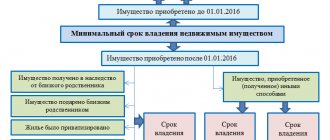The question of how to register houses under the dacha amnesty has been very relevant throughout the country in recent years. The federal law, which is in force today and allows for the registration of private ownership of existing real estate in a simplified manner, was adopted in 2006 and was initially of a temporary nature. However, despite a number of various obstacles and disagreements between legislators, it was repeatedly extended and is still in effect today. Today, the entire procedure is regulated by Federal Law No. 20 of February 28, 2015, which amends the previously adopted one.
Thanks to the dacha amnesty, as it is called, citizens have the opportunity to quickly and easily register property rights, and this opportunity has been extended until the end of December 2021.
Dear readers!
Our articles talk about typical ways to resolve legal issues, but each case is unique. If you want to find out how to solve your specific problem, please contact the online consultant form on the right →
It's fast and free!
Or call us by phone (24/7):
What is a dacha amnesty?
A dacha amnesty, in particular for housing construction projects, is a simplified procedure through which it is actually possible to register the personal right of ownership of an actual property, regardless of its location in Russia. To start the process for individual housing construction (IHC), you need to make sure that you have legal documents that can irrefutably confirm your real rights to use and own the property.
Often people are faced with the problem of losing a legal document, which is very difficult to recover. In addition, we are often talking about paper that was issued a really long time ago. Despite its validity period, if it is available and executed correctly, in accordance with the requirements at the time of issue, you have nothing to worry about. In fact, since 1998, they launched the property rights registration system that is in effect today. For this reason, a document certified by the local government authority, including a certificate from the technical inventory bureau, has full legal force. Based on the above, we conclude that the essence of the dacha amnesty is to guarantee the preservation of ownership rights to everyone who has old-style papers in their hands.
If there is no document confirming the title, but the property belongs to you and you are absolutely sure of this, you need to contact the local government body with an official statement, which sets out a request for the issuance of an extract made from the business book. Sometimes this is impossible for various reasons, which means that the property will have to be purchased from the state or municipality.
Who can participate in the dacha amnesty
State (compulsory for everyone without exception) registration and private registration of a country house under the country amnesty are now available not to everyone, but to strictly defined categories of persons who:
Registering a house on your own is not so difficult; moreover, under the terms of the dacha amnesty, you can do this completely free of charge. In this case, both the land and all the buildings that are on it must be registered.
Citizens of the country have the opportunity to legally register six acres of land in their own name if they received it for free use before 2001, when there was no Land Code yet.
How to register your own country house in 2021 - step-by-step instructions
The cost of drawing up technical plan varies between 5 - 10 thousand rubles, which directly depends on the area and configuration of the building. The duration of the work is about a month. Those objects that have already been registered previously and have a cadastral number are exempt from the need to have a technical passport. That is, calling cadastral specialists is only necessary in cases where the registration of a garden house is carried out for the first time.
We recommend reading: What is the difference between Temporary Registration and Permanent Registration
If buildings do not belong to the category of capital construction, they are not required to be registered. In addition, if the land was received before 2001, that is, before the Land Code came into force, privatization and transfer of land into ownership is also carried out according to an accelerated and simplified program on a free basis. The received documents have equal validity with documents of title to plots acquired after the specified date.
What objects are suitable for the program
The dacha amnesty for individual housing construction actually allows you to register in a simplified manner such locally immovable objects as:
- A residential building, if it was once built on land for permitted individual housing construction (IHC);
- A building directly located on the territory designated by law for non-commercial subsidiary and so-called personal farming, which needs to be registered;
- A garden house of any type, located on a plot of private property, provided for work such as gardening, dacha farming, any construction, which is also fully covered by the dacha amnesty;
A garage for transport, an auxiliary shed, any utility block, a barn, as well as, for example, a gazebo on an area that is documented for individual construction;
- Another house or other existing building, if a permit is required for their construction.
To understand exactly how any type of house or building is registered directly under the dacha amnesty, it should be noted that it is possible to register it in a simplified manner only in the specific case if they are built on land with a specified purpose. In addition, as you can see from the above, you can decorate virtually any house in gardening, and a non-residential property. It is equally important that the dacha amnesty applies only to non-commercial real estate.
The concept of a declaration for registration of a country house
A declaration for registration of a country house is a requirement established by law, as well as various legal acts, to determine the procedure and form of registration actions.
Let's celebrate! The declaration form is a prerequisite for the implementation of the dacha amnesty. It is he who allows you to enter all the necessary information about the land plot and the basis of its ownership, as well as the buildings located on the site.
The need for a declaration will arise:
- when registering land;
- in connection with the legalization of buildings on the site.
This document greatly simplifies obtaining legally significant confirmation of the right to a house and other outbuildings, including garages.
How to register a house under the dacha amnesty
When considering in detail the process of registering any type of real estate that is located on a site subject to a simplified procedure, you should determine a list of essential documents that you will need to have in any case. It includes:
Despite the fact that now technical documentation is actually completely replaced by more current cadastral documentation, there are situations in which there is no need to provide a cadastral passport:
- The plot was registered by you, and information about this is available in the Unified State Register of Real Estate;
- The land under the house was allocated for gardening or dacha farming, which is confirmed by a conclusion from the management of the non-profit association (land in partnerships and cooperatives);
- An object is registered, the construction of which does not require a permit (in this case, you need to document that this property is located strictly within the boundaries of the site you own).
Declaration or registration certificate
A declaration or, as an analogue, a technical passport for a residential building is nothing more than legal documentary evidence of the fact of the actual creation of a real estate property on your personal site. This reliable document can fully serve as a valid basis for the legal registration of rights to a building of any type under the dacha amnesty. The technical passport is issued by the Technical Inventory Bureau, while the declaration is filled out personally by you and must have your signature.
In accordance with the previously approved order of the Ministry of Economic Development of the Russian Federation No. 447, adopted on November 3, 2009, the declaration has a unified form (form).
In accordance with legal regulations, the declaration is filled out and submitted in two original copies, each of which contains the following:
- Location of the object;
- Name of the building;
- Type of building;
- Number of floors, including underground floors;
- The year in which the structure was erected;
- Total area;
- Materials used in the construction of capital structures;
- Available engineering and technical communications;
- Land number according to the cadastre;
- Information about the owner.
Step-by-step instruction
For the legal and simplified registration of your existing house as property under the dacha amnesty, the sequence of actions is very simple and understandable:
What is a declaration of real estate?
Citizens of the Russian Federation often think about what a real estate declaration is, where to submit it and how to fill it out correctly. For them, we answer that this is a document of the established form containing a description of all the characteristics of the declared property and securing ownership of it by an individual or legal entity.
The form of this document is approved by order of the Ministry of Economic Development. Which should be submitted to government bodies determined by law in order for the copyright holder to certify his property rights.
The requirements for filling out the form are regulated by Federal Law No. 218 of July 13, 2015, dedicated to issues of state registration of real estate (Article 18). To obtain a positive decision on your application, we recommend that you provide information in full and attach title documents.
Federal Law N-218
How to fill out a declaration on a real estate property?
After the formation of the Unified State Register of Real Estate, the application form changed.
Order of the Ministry of Economic Development 689 dated November 1, 2021 also contains requirements for completion. An example of a completed form can be found on the Internet or at an authorized government agency. You must fill it out carefully, excluding mistakes and blots, otherwise you may receive a refusal.
Order of the Ministry of Economic Development of the Russian Federation N-689 in the latest edition
Sample of filling out a declaration on a real estate property
When filling out a declaration, you may encounter two orders from the Ministry of Economic Development, according to which the declaration is drawn up in a new form. These are orders dated December 18, 2015 No. 953 and dated November 1, 2016 No. 689, the first of them stated the approval of the form, the second has already been issued on its basis and directly contains new requirements for declaration.
Declaration of real estate - sample
Where to submit a declaration on a real estate property?
Registration of the declaration in 2021 takes place at Rosreestr, the Cadastral Chamber or through the Multifunctional Center (MFC). The completed form can be submitted in paper or electronic form. The legislation also provides for both personal submission and sending of documents by Russian post.
The new edition of 218-FZ allows the submission of an application to it in any division of the above government agencies, regardless of the address of the property. Before the changes entered into legal force, a completed form with attachments had to be provided when the object of declaration was located within the boundaries of the cadastral or registration district. You also need to pay the state duty (Article 17 of the Federal Law-218) provided for by the Tax Code (Article 333.33). Individuals should be aware that property tax will be calculated based on the cadastral value.
Federal Law of the Russian Federation - Article 17
Federal Law of the Russian Federation - Article 333.33
Advantages of privatization under a simplified procedure
A special advantage of the dacha amnesty, which in particular applies to individual housing construction, is the implementation of free registration of property rights. It is too early to predict whether it will last beyond 2020, so you should not put the procedure off for a long time.
Citizens who are active participants in vegetable gardening or horticulture, any country farms, cooperatives, have even more advantages. In accordance with the current Land Code, or rather, with the amendments made to it in March 2015, they have the opportunity to register property rights through local governments and with a minimum package of papers. In this case, the date when a person joined the cooperative no longer matters.
Main advantages
Possible reasons for refusal
Before registering a house using the dacha amnesty, you should pay attention to the fact that there are several reasons why you may be refused. Regardless of whether a garden house or a residential building is registered, the requirements are always identical. Reasons for refusal may be:
- Discrepancy between the actual area of the plot and that included in the cadastral documents;
- Inconsistencies in the survey boundaries specified in the documents;
- Lack of required papers that were listed earlier in the article (submission of an incomplete package);
- Falsification of information;
- Registration of land ownership after 2001.
Registration of houses under the dacha amnesty is not a difficult path, but this does not at all relieve you of the responsibility that lies with you as the owner of the property.
Procedure for assigning an address
Each piece of real estate must have a personal postal address, and this is also a necessary measure when registering rights in a simplified manner under the dacha amnesty. When thinking about where to start, and if there is no address, how to register in the house, first of all it is worth noting that it is impossible to register residents if the address has not been assigned to the house.
Assigning addresses is the responsibility of the municipality, therefore, with the corresponding application and documents regarding the residential building, which will appear when registering as alienated property under the dacha amnesty, you need to apply there. As for documents, these are papers giving the right to the building and the land on which it is built. After submitting an application with documents, the address will be assigned within no more than thirty calendar days.
Once the house has been assigned an address, you will need to start actually obtaining a cadastral individual passport. Only after this can you apply to Rosreestr for registration of ownership.
Registration rules
In order for a real estate object to become the subject of property rights, that is, to carry out civil transactions with it, it must be registered with Rosreestr and receive its own unique cadastral number, which makes it possible to register it as property. The provisions of Federal Law 218 establish the mandatory registration procedure and the procedure for processing documents. Recently, the declaration form and the rules for filling it out have been updated.
Currently, you can register your dacha ownership without permits for the property or without construction documentation. In addition, it is possible to submit documents for registration even in the absence of permission to put the facility into operation, a construction project or a cadastral passport.
Thus, a technical plan of the property must be attached to the declaration. It is compiled by cadastral engineers or BTI specialists. The procedure is carried out in a simplified manner.
Suitability of the house for habitation
Before submitting a declaration for a dacha amnesty, it is also important whether a private residential house will be recognized as suitable for permanent residence, and this depends on many nuances. In particular, the second part of Article 15 of the Housing Code states that a residential building can only be an isolated premises that a group of people can use for permanent residence due to compliance with sanitary and technical requirements.
Government Decree No. 47 of January 28, 2006 contains a complete list of criteria that residential premises must meet.
Suitable
The criteria by which housing is assessed, and by which experts determine whether it is suitable for habitation, include:
- A serviceable capital structure of the house, its walls, racks, insulation, making the structure safe and reliable;
- Absence of factors that may threaten the health and lives of people inside and near the facility;
- Availability or possibility of location of engineering communication systems (electricity, water, sewerage, heating systems, gas supply, ventilation equipment);
- Availability of devices for uninterrupted drainage in accordance with safety rules;
- Protection against penetration of groundwater, rain and melt water;
- Compliance with permissible noise levels, electromagnetic radiation, vibrating interference in the house;
- Permitted level of concentration of harmful substances, especially for garden buildings.
If a building does not meet at least one of these points, its registration as a residential building under the terms of the dacha amnesty becomes impossible.
Not suitable
There are also certain factors on the basis of which real estate is considered unsuitable for permanent residence. The reason for declaring a house unsuitable is:
Expert commission
To consider the issue of suitability, a special commission of experts created by the local municipal body is involved. And the first thing you need to know is that her verdict can be appealed in court. The expert commission includes representatives:
- Executive bodies;
- Structures that exercise local housing control;
- Sanitation and Epidemiology Supervision Authorities;
- Fire, environmental and industrial areas;
- The body that deals with inventory and registration activities;
- Organizations in the field of urban planning and architecture in the region;
- Professionals of survey and design institutions with a state license.
The owner of the real estate property also has the right to vote when making a decision.
A commission of experts examines the house itself, as well as all documentation relating to it. Based on the results of the work done, a report is drawn up, which will then be handed over to each member of the commission for consideration. The review period is one month, then a date is set when the final verdict is announced, that is, when you find out whether the property is considered suitable or unsuitable for habitation. If necessary, additional examination with appropriate tests is carried out.
How to register in a decorated house
The rules for registration and the procedure for registering a house are clearly regulated in the current legislation of the Russian Federation, in particular when it comes to the dacha amnesty. For example, it is stated that you can only register in a house that is located on an area intended for individual housing construction, a dacha or a garden area. If in the first case there are no difficulties, then in the last two, first you will have to transfer the building to residential status. That is, the object must meet all the requirements listed above.
Documents for transferring a building to residential status:
Based on these documents, a decision will be made within forty-five days. After this, if the request has been approved, you will receive the relevant transfer papers within three days after the approval is accepted. Having this document in hand, you can register with the migration service at the location of the property.
How to fill out a real estate declaration
By order of the Ministry of Economic Development of Russia dated December 13, 2010. No. 62 establishes the form of the declaration and the procedure for filling it out. The document can be prepared on paper or in the form of an electronic file. It is worth considering:
- The paper version is drawn up on A4 sheets, which must be stitched together;
- The electronic document is prepared in XML format. Only the form certified by the enhanced digital signature of the applicant is sent; the system requirements for the key certificate must be clarified on the Rosreestr website and this must be done right before sending the document, since such information may change depending on innovations in the operating system. The digital signature and the document itself can be verified within sixty days from the moment they are entered on the service’s website.
property declaration
The document is filled out in two copies by the applicant in his own hand. Information is entered in printed form without abbreviations. All fields must be filled out; dashes are added only in exceptional cases. Absence of values in the column is marked with a dash. The columns indicate:
- The information about the address of the property indicates its location, the legally assigned postal address to the house. In its absence, the name of the subject of the Russian Federation, locality, street, etc. is indicated;
- When putting down the type of structure, a mark opposite the appropriate name: for a house, the column - building is noted, for a private building - a residential building, for a bathhouse or barn - another structure, an apartment or room - premises, a garage refers to buildings, unfinished buildings are entered in the column of the cadastral number, the room is marked under the cadastral number of the apartment;
- When the only room in a building is registered, it is assigned the cadastral number of the building itself. If there are several buildings, a declaration is drawn up for each;
- In the technical description of the property, the total area in square meters is entered. m. not taking into account the size of the balcony, veranda, loggia and terrace. All dimensions are rounded: length - up to 1 meter, for underground structures depth - up to 0.1 m, area - up to 0.1 sq. m., volume – up to 1 cubic. m., height - up to 0.1 m. For unfinished objects, the degree of readiness is indicated in %, calculated by the formula:
Degree of readiness = 100 x cost of actually completed work / total amount of construction work (indicated from the estimate in rubles);
- Construction materials used;
- Year of completion of the building;
- Availability of communications connected to the house for gas, water, electricity and sewerage;
- The copyright holder indicates the applicant’s passport details, his SNILS and place of registration. If the land territory belongs to a legal entity, then its details are entered;
- Information about common ownership must be completed if there is a common share in the property. In this case, the share is indicated in the form of a simple fraction;
- Upon completion, the date of completion of the document is indicated, the signature and full name of the person are affixed.
A sample of the filling can be seen on the website of the Federal Tax Service of Russia or at the stands of multifunctional centers.
Now data can be submitted not only about the type and purpose of the property, but also its full name. By the way, the structures may relate to livestock, fuel and energy or transport complexes. Based on the submitted documentation, the owner has the right to issue a new cadastral passport and land plan, but only if all other papers meet the requirements of current legislation. Upon completion of the registration procedure, the previous object is deregistered, and the new one is entered into the state cadastre with amended data on the erected structures, assigning it a new individual number and the code of the quarter where such property is located.
The document must indicate the purpose of construction of the facility.
Difficulties and nuances
It is equally important to know what difficulties you may encounter before registering a country house under the terms of the amnesty. The most common ones include the following:
- Difficulties in proving your rights to real estate: you have to personally visit a number of institutions to collect evidence in the form of certificates and extracts;
- The need to go to court to challenge the decision of the expert commission in order to register in the house: this takes a lot of time and delays the desired result, requiring additional financial investments;
- Incorrect recording of information in cadastral documents, which also slows down the process and often becomes the reason for refusal: you have to spend a lot of effort and time to establish correct data.
However, despite the practical difficulties, as a rule, they are all solvable, the only question is time and your efforts.
Dear readers!
It's fast and free!
Or call us by phone (24/7).
Registered land on the territory of the Russian Federation is divided into certain areas with different purposes. According to Russian legislation, it is possible to build a house, legalize a building on a plot, register it and register ownership only if the land is geographically part of a populated area or is intended for use for agricultural purposes.
On a summer cottage plot, which is located within the infrastructure, you can build a house and register it as property, but on plots intended only for gardening, there is a chance to register only a non-residential building.
If we are talking about legalizing a house on a plot after its construction and then registering it as a property and obtaining title documents, then first you should. However, it is not necessary in all cases. Also, government authorities will pay attention to compliance with the building standards that apply to the dacha.
To navigate the process and understand the sequence of actions, let’s consider what documents need to be prepared and how registration takes place.
Dear readers!
Our articles talk about typical ways to resolve legal issues, but each case is unique. If you want to find out how to solve your specific problem, please contact the online consultant form on the right →
It's fast and free!
Or call us by phone (24/7):
Refusal to accept the declaration
A completed and stapled declaration does not guarantee automatic acceptance. You need to be prepared for the possibility that your application will be refused.
The list of grounds for refusal includes:
- contains errors or corrections made in an unacceptable manner;
- when filling out, a stationery item other than a ballpoint pen with black or blue ink was used;
- the sheets have visible damage;
- the information entered is untrue and false;
- lack of papers that must be attached by law.
The time limit for conducting the inspection is 20 working days. During this time, a check is carried out to ensure that the provided material complies with the requirements set by law.
State policy aimed at providing Russian citizens with the right to legalization and the possibility of alienation in any way is being implemented extremely poorly. The most simplified procedure still causes difficulties, because filling out the declaration yourself is often accompanied by errors.
Let's celebrate! This is because it is difficult for a person who does not have special knowledge to cope with filling out such documents. In view of this, parliamentarians decided to extend the period of the “Dacha Amnesty” until March 1, 2021.
Didn't find the answer to your question? Find out how to solve exactly your problem - call right now: +7 (Moscow) +7 (812) 309-53-42 (St. Petersburg) It's fast and free!
Construction permit
The procedure for obtaining a building permit on a summer cottage, be it a garden house, a residential building or another structure, is strictly regulated by the Town Planning Code of the Russian Federation. It contains confirmation that the project documents comply with the requirements and gives the owner the right to carry out capital construction on its territory. You can complete the paperwork by contacting your local government, for which the applicant will need:
The submitted application and documents are considered within ten days from the date of their submission and registration. After a positive decision is made, a permit is issued for a period of ten years.
You do not need to obtain permission for the construction of such objects as:
- A garage that is the property of an individual and is not used for commercial activities;
- Buildings intended for gardening and horticulture;
- Auxiliary room;
- The object is not capital construction. For example, a canopy;
- Minor modification to an existing building.
Features of registration of buildings on a dacha plot under the dacha amnesty
Let's summarize. After deciding to build a house on land, you should think about carrying out registration through legal methods in order to obtain ownership of it. A plot of land for such purposes is usually leased and therefore you should worry about obtaining ownership of it too.
You can increase your dacha plot by registering so-called “additions”—land occupied without permission. Previously, such actions were prohibited, but the owners of the site still erected fences on someone else’s territory. Now, if the extensions were attached a long time ago, they can be formalized for a small fee.
Compliance with the rules
To register ownership of a residential building or other building at a dacha, government agencies submit documents for the property, which are checked for compliance with the law. These include the requirements that outbuildings should not be located less than five meters from the driveway line and the street, and if there are neighbors, there should be a lattice or mesh fence at least one and a half meters high. A blind fence can only be installed on the side of the street and driveway. In this case, the participants of the garden cooperative must give their consent to this.
If a house on a summer cottage is used to keep poultry, it must be located at a distance of at least one meter from other buildings and at a distance of four meters from the neighboring property. The absence of runoff to neighboring areas will also be taken into account. Documents will be checked for fire safety and sanitary standards.
Registration of a house on a site is mandatory for all owners, so close attention should be paid to all construction rules and regulations. Failure to comply will make it impossible. The local government authorities will issue a refusal to the owner and send the case to court for further proceedings. This, in turn, will entail financial expenses, fines and compensation for damage caused to neighbors and other owners.
Commissioning permit
According to the norms of Russian legislation, when registering rights, there must be permission to put the house into operation after completion of construction or completion of major repairs. It is attached to the building permit, and these documents are kept until the property is liquidated. To obtain the appropriate document, the owner contacts the same organization that issued the construction permit. A similar application is written and the following documents are attached to it:
| Title of the document | Notes |
| Certificate of land ownership | And all other legal documents |
| Urban development plan for the dacha | Land plan |
| Construction permit | If it was received |
| Real estate acceptance certificate | When was reconstruction or major repairs carried out? |
| Documentation confirming the compliance of a house or other structure with technical requirements | With the signature of the person who carried out the construction, major repairs or reconstruction |
| Confirmation of compliance with technical specifications | Signed by relevant organizations |
| Property plan | With the location of the engineering support network and the designation of territory boundaries |
How to properly file a declaration?
To obtain a final document confirming ownership of buildings erected independently, without conciliation procedures, you must fill out a document form. The requirements for filling out the declaration form were approved by order of the Ministry of Economic Development of the Russian Federation dated November 3, 2009.
The main conditions are:
- To be completed by the applicant personally.
- Availability of land documents.
- A country house built without permission.
- Possession of information about the material from which a house or other household items are built. the buildings.
- It can be filled out independently or with the participation of intermediary companies.
- As well as others provided for by special regulations.
It is important to note! That the form must be filled out using a ballpoint pen with black or blue ink. Entering some data may be required in specially marked cells, and here it is important to know that each character (letter or punctuation mark) is entered in a separate cell in block letters. To separate words, a cell is used, which is left empty.
Required documents
Along with the declaration, other documents must be submitted to Rosreestr. They will make it possible to establish the fact of ownership or use by the applicant of the land plot by the person who applied for the legalization of buildings and recognition of his ownership of real estate objects.
These include:
- application for registration of rights;
- identification document of the applicant;
- documents for a plot of land;
- cadastral passport and site and house plan;
- confirmation of payment of government fees.
Let's celebrate! The presence of the listed documents will allow Rosreestr employees to verify the submitted data and register real estate rights.
Declaration structure
The declaration, like any other document, contains the following points:
- Information about where the property is located.
- Type of building (house, garage, bathhouse, etc.).
- The nature of the constructed structure (residential or non-residential premises).
- Information about the assigned cadastral number of the land plot;
- Indication of the technical characteristics of the erected structure (material, number of floors, plan, area, etc.).
- Information about who owns the object for which the declaration is being drawn up.
If there are several owners of a self-built construction project, it is necessary to fill out section No. 7 of the declaration.
Requirements for document preparation
The requirements for the document are simple and understandable to everyone. To fill it out, you do not need to obtain or study additional information and data. Everything you need should be at hand. The declaration can be made either in written or electronic form.
The list of writing requirements includes:
- must be filled out in legible handwriting;
- the applicant fills out the form with his own hand or through an intermediary;
- the need to enter information about the cadastral number of the land plot;
- availability of data on the right to use or ownership of land;
- It is not allowed to make corrections or cross-outs in the completed form;
- The wording of the text should not have double interpretation.
- The declaration must be clean and show no signs of damage or repair after damage.
Filling out the declaration electronically implies certain features:
- the format of the electronic document must be XML;
- the contents of all schemes and plans are required;
- the need for the applicant to have an enhanced electronic digital signature.
How to fill out the document correctly?
The current requirements for the rules for filling out the document are contained in the Rosreestr web portal, as well as many Internet resources. Examples of legally correctly completed declaration pages are available on the Internet.
Don't forget! That if any uncertainty arises, you should seek competent legal advice from a specialist with experience in handling such cases.
Firmware before submission
A correctly completed form does not guarantee acceptance of the declaration and registration of the corresponding document. There is also a requirement to flash the declaration before submitting it.
The firmware procedure involves going through some stages:
- checking the text for spelling errors and subsequent proofreading;
- neatly folded sheets should be aligned;
- The sheets are fastened with a paper clip in the upper right corner.
Good to know! It is considered extremely undesirable to staple sheets using a stapler, since this method can damage both the sheets and the information contained.
Registration question
To register a dacha house as your own, the ownership of this property must be registered. State registration is mandatory for any buildings, no matter what their intended purpose. Each is issued with a certificate confirming the right of ownership.
When registering a house on a summer cottage, if permission was not required for this building, the owner must fill out the appropriate declaration. Registration will take place on its basis. The declaration form is filled out at the place of application.
You will also need additional documents such as:
- Cadastral passport and permission to put into operation;
- Technical documentation for the structure;
- Certificate of ownership of the dacha plot;
- Applicant's passport;
- A receipt indicating that the state fee has been paid.
Dear readers!
It's fast and free!
Or call us by phone (24/7).
The dacha amnesty is designed to help people, without unnecessary delay, formalize ownership rights to land plots and residential buildings, garages, garden houses and other buildings located on them. It is sometimes difficult to do this in the usual manner due to the lack of necessary documents. Daria Pronikova, director of the branch of the Federal State Budgetary Institution “FKP Rosreestr” for the Nizhny Novgorod region, tells how to avoid all the pitfalls.
Instructions
Rosreestr accepts declarations based on correctly executed documents for the site itself. You can register a building even on the basis of a lease agreement, but only on the condition that the construction has already been completed and put into operation, which is managed by the Inventory Bureau. An important condition is to correctly fill out the text of the declaration: without erasures or corrections, in printed rather than capitalized text.
The main stages of registering ownership of a summer cottage:
You can submit a document for registration of ownership rights only for one piece of real estate, describing in detail:
- Detailed location of the building, which constituent entity of the Russian Federation it belongs to.
- Exact description of the type: for year-round or summer use, summer construction or intended for use all year round, type of use: for household or other needs.
- Cadastral registration data: plot number.
- The largest and most voluminous subsection describes the characteristics of the building, what communications are laid, what building material it is built from, how many floors and whether there is a basement. The declaration form itself already has all the data, you just need to mark it correctly.
- Then they describe the data about the owner of the constructed building, where he is registered permanently or temporarily, and the data from his civil passport. If there are several owners, then provide information about all of them, indicating their share.
- Sign and date the form.
It is worth remembering that by submitting such a document to register property rights, a citizen thereby confirms the data specified in the declaration.
If the data is unreliable, the owner may be subject to administrative punishment.
After registration, all documents will be transferred to the cadastral chamber for registration.
Dacha amnesty extended
“Dacha amnesty” is a simplified mechanism for registering ownership of a number of land plots and real estate objects, introduced by Federal Law No. 93-FZ of June 30, 2006 (the so-called Dacha Amnesty Law). Many people are interested in the question: for how long has the dacha amnesty been introduced? With regard to lands and individual residential buildings located on them, the validity of the dacha amnesty has been extended until 03/01/2018 (previously it was planned to be completed by March 2015). Before this date, you can register the right to a house, even if it does not have permission to put it into operation.
But there is another mechanism introduced by the same 93-FZ - free privatization of country, garden and vegetable lands. According to amendments to the Land Code of the Russian Federation, effective from March 1, 2015, members of dacha, vegetable gardening and horticultural partnerships or cooperatives are allowed to register a land plot for free in a simplified manner until December 31, 2021 (initially, the deadline for free privatization of land was not limited by law) .
Features of registration of buildings on a dacha plot under the dacha amnesty
When you register your dacha and outbuildings as your property, you will have to pay taxes on them. What is the procedure for paying taxes? After registering property rights, you will have to pay land tax. It is calculated by multiplying the tax rate by the cadastral value of the site.
- Houses built on lands allocated for individual housing construction;
- Residential buildings located on the territory of subsidiary farming or gardening;
- Any buildings standing on lands provided for dacha activities;
- Structures for which construction does not require permission.
Dacha land amnesty
The dacha amnesty is intended primarily for those who received land plots in Soviet times or at the dawn of reforms, but have still not formalized their rights to them, or have an old-style land certificate.
It does not matter whether the land was provided for ownership, for permanent (indefinite) use, on the basis of lifelong inheritable ownership, or without any indication of the transferred right at all. In each of the above situations, it is possible to register ownership rights.
The only exceptions are those cases when the plot was transferred for temporary use (lease), or was received after the entry into force of the Land Code, that is, after October 30, 2001 - the dacha amnesty does not apply to such situations.
In order for rights to be allowed to be registered in a simplified manner, the land plot must meet two criteria
:
Be provided to the citizen before the Land Code comes into force;
Designed for personal subsidiary farming, summer cottage farming, vegetable gardening, horticulture, individual garage or individual housing construction.
Real estate objects, the rights to which can be registered in a simplified manner, include:
- real estate objects for the construction/reconstruction of which a building permit is not required;
- objects of individual housing construction on a land plot intended for individual housing construction.
- objects of individual housing construction on a land plot located within the boundaries of the settlement and intended for running personal subsidiary plots (on a personal plot of land).
- outbuildings and structures, garden and country houses, erected on land plots intended for gardening and country farming.
| Difficulties in registering real estate under the dacha amnesty It happens that information about the area of the plot indicated in the title documents for the plot differs from what actually exists. In the early 90s of the last century, land was allocated without appropriate measurements, one might say “by eye.” In this case, it is necessary to carry out land surveying. The legislator “allows” to increase the total area of land. But... The increase cannot exceed one value of the minimum permissible plot size for a specific category of land. If the boundaries were not determined at all in the manner prescribed by law, then an increase is possible by no more than 10% of the area of the site, which is registered in the state real estate cadastre. Remember: discrepancy between the actual area and the size of the land plot indicated in the documents cannot serve as a basis for refusal to register property rights. |
How to register a summer cottage and a house: step-by-step instructions
A plot of land for running a personal subsidiary plot, on which buildings can be erected, for individual housing construction, needs to go through the procedure of state registration of property rights. To do this, you need to provide a cadastral passport and in order to receive it, you need to register it, pay a fee, and after that you can receive a cadastral passport at home.
The simplified registration scheme really resembles an amnesty , since the first stage consists of filling out a declaration, as well as measuring the area of all buildings in the country. A completed declaration of real estate is actual confirmation of the creation of a registered property of your own. It is also the basis document for acquiring ownership of the building and the opportunity for further state registration of one’s rights.







